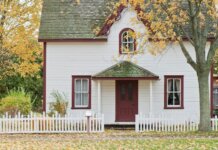The increase in home prices is spurring some trade-up activity in the mortgage market, according to a report released this week by mortgage technology company FNC.
The firm reports that steadily rising home prices have put some homeowners back into positive equity and thus in a position to sell. What's more, an improved outlook on the economy among consumers has resulted in some buyers taking advantage of still-historically-low home prices.
‘We've seen hard data from the past 18 months that shows rising home prices and a foreclosure market with diminished impact due to decreasing foreclosure inventories and fewer new foreclosure filings,’ says Yanling Mayer, director of research for FNC, in a release. ‘Meanwhile, a very encouraging trend that has been developing is the rising participation of trade-up buyers who are seeing improving home equity position and positive capital appreciation on existing homes.
‘An important sign of a healthy and sustainable recovery is increased housing turnover driven by trade-up buying, which is more or less discretionary spending,’ Mayer adds. ‘These buyers are typically more responsive to market conditions and financial incentives.’
FNC's Foreclosure Market Report shows that foreclosure volume continues to drop as the economy improves. As a result, foreclosure volume is now approaching pre-crisis levels.
The report shows that foreclosure price discounts, which compare a foreclosed home's estimated market value to the price paid by investors or home buyers, dropped to a 10-year low in the second quarter to reach about 8.1%, down from 12.5% in the second quarter of 2012.
At the height of the mortgage crisis in 2008 and 2009, foreclosed homes were typically sold at close to 25% below their estimated market value, FNC says. In many fast-rising markets, such as Phoenix, Las Vegas, and California, investor activity and low foreclosure inventory drove foreclosure prices up in the second quarter, frequently resulting in a price premium relative to estimated market value.
Despite this, investing in foreclosed property continues to be profitable, the report finds. Gross capital appreciation – the annualized percentage difference between a foreclosed property's sales price and subsequent resale price – averaged 7.8% in the second quarter. That means investors – on average – made 7.8% in profit on each ‘flip,’ excluding the cost of any property improvements.
Single-family real estate-owned and foreclosure sales represented 12.2% of total home sales as of July, down from 17.3% a year ago, according to the report.
The median foreclosure price in the second quarter was $98,000 or $67 per square foot, up 6.8% since the housing recovery began 18 months ago. In comparison, the median price on non-foreclosure sales was $205,000 or $118 per square foot, up 21.7% during the same 18-month period.
Michigan continues to be the nation's most distressed market with one in three homes sold during the second quarter being foreclosed properties.
States that saw the fastest declines in foreclosures in the second quarter included Arizona, California, Nevada and Oregon. At 3.2% of total home sales, the District of Columbia had the lowest foreclosure rate.
States with continued high foreclosure rates included Alabama, Illinois, Michigan, Ohio, Rhode Island, South Carolina and Tennessee. FNC notes that foreclosure rates in Alabama, Illinois, Indiana, and Kentucky are trending steadily upward in recent months, dampening home prices.
Cities that saw the fastest declines in foreclosures included New York, Boston, Portland, San Francisco and Washington D.C., while cities with continued high rates of foreclosure included Detroit, Chicago, Cleveland, Atlanta and Cincinnati.
For more, check out the full report.













